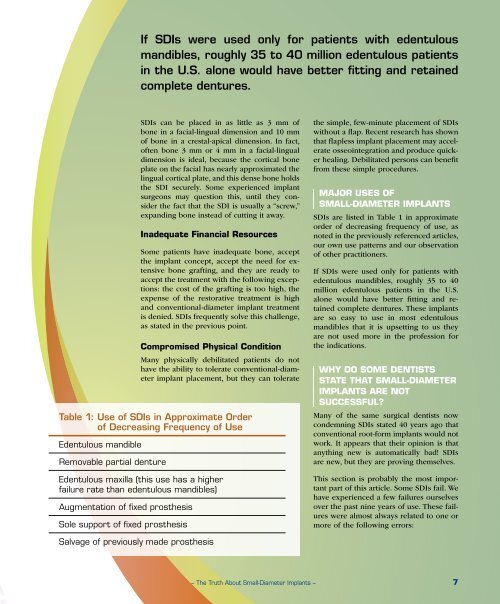Inclusive - Glidewell Dental Labs
Inclusive - Glidewell Dental Labs
Inclusive - Glidewell Dental Labs
Create successful ePaper yourself
Turn your PDF publications into a flip-book with our unique Google optimized e-Paper software.
If SDIs were used only for patients with edentulous<br />
mandibles, roughly 35 to 40 million edentulous patients<br />
in the U.S. alone would have better fitting and retained<br />
complete dentures.<br />
SDIs can be placed in as little as 3 mm of<br />
bone in a facial-lingual dimension and 10 mm<br />
of bone in a crestal-apical dimension. In fact,<br />
often bone 3 mm or 4 mm in a facial-lingual<br />
dimension is ideal, because the cortical bone<br />
plate on the facial has nearly approximated the<br />
lingual cortical plate, and this dense bone holds<br />
the SDI securely. Some experienced implant<br />
surgeons may question this, until they consider<br />
the fact that the SDI is usually a “screw,”<br />
expanding bone instead of cutting it away.<br />
Inadequate Financial Resources<br />
Some patients have inadequate bone, accept<br />
the implant concept, accept the need for extensive<br />
bone grafting, and they are ready to<br />
accept the treatment with the following exceptions:<br />
the cost of the grafting is too high, the<br />
expense of the restorative treatment is high<br />
and conventional-diameter implant treatment<br />
is denied. SDIs frequently solve this challenge,<br />
as stated in the previous point.<br />
Compromised Physical Condition<br />
Many physically debilitated patients do not<br />
have the ability to tolerate conventional-diameter<br />
implant placement, but they can tolerate<br />
Table 1: Use of SDIs in Approximate Order<br />
of Decreasing Frequency of Use<br />
Edentulous mandible<br />
Removable partial denture<br />
Edentulous maxilla (this use has a higher<br />
failure rate than edentulous mandibles)<br />
Augmentation of fixed prosthesis<br />
Sole support of fixed prosthesis<br />
the simple, few-minute placement of SDIs<br />
without a flap. Recent research has shown<br />
that flapless implant placement may accelerate<br />
osseointegration and produce quicker<br />
healing. Debilitated persons can benefit<br />
from these simple procedures.<br />
MAJOR USES OF<br />
SMALL-DIAMETER IMPLANTS<br />
SDIs are listed in Table 1 in approximate<br />
order of decreasing frequency of use, as<br />
noted in the previously referenced articles,<br />
our own use patterns and our observation<br />
of other practitioners.<br />
If SDIs were used only for patients with<br />
edentulous mandibles, roughly 35 to 40<br />
million edentulous patients in the U.S.<br />
alone would have better fitting and retained<br />
complete dentures. These implants<br />
are so easy to use in most edentulous<br />
mandibles that it is upsetting to us they<br />
are not used more in the profession for<br />
the indications.<br />
WHY DO SOME DENTISTS<br />
STATE THAT SMALL-DIAMETER<br />
IMPLANTS ARE NOT<br />
SUCCESSFUL?<br />
Many of the same surgical dentists now<br />
condemning SDIs stated 40 years ago that<br />
conventional root-form implants would not<br />
work. It appears that their opinion is that<br />
anything new is automatically bad! SDIs<br />
are new, but they are proving themselves.<br />
This section is probably the most important<br />
part of this article. Some SDIs fail. We<br />
have experienced a few failures ourselves<br />
over the past nine years of use. These failures<br />
were almost always related to one or<br />
more of the following errors:<br />
Salvage of previously made prosthesis<br />
– The Truth About Small-Diameter Implants – 7

















